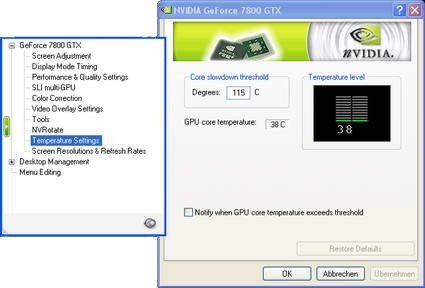Seven of NVIDIA's Latest and Greatest Cards Tested
Overclocking And Heat
Owners of an eVGA card with higher default clock speeds, like the Black Pearl, have to install eVGA's driver at least once, or set the card to run at higher clock speeds manually.
The first solution is to install the eVGA driver and then install NVIDIA's reference driver over it; the second is to install the current NVIDIA reference driver and use the Coolbits registry hack to unlock the driver's frequency selection dialog. The driver will display a warning regarding the potential loss of warranty resulting from overclocking, as usual, but eVGA guarantees the Black Pearl's operation at the increased frequencies, so you're on the safe side. The eVGA card's default frequencies are 600/1800 MHz and these should not cause any heat-related damage to the hardware.
In our test, the GPU reached 38 degrees Celsius in 2D mode; when running a 3D application, the temperature rose to 50 degrees. The 120 mm radiator fan was used in 7V mode for all measurements.
Get Tom's Hardware's best news and in-depth reviews, straight to your inbox.

